Tuesday 17 May 2016. To Vout-o-Reenee’s to take a photo. It’s for my entry to a Birkbeck competition, which is asking for photos on the theme of ‘London Relocated’. An idea occurred to me, so I thought I’d give it a go. I thought about the way the Vout’s club is effectively the spirit of bohemian Soho relocated, in this case a few miles east in Tower Hill. Tonight I get Sophie Parkin to pose at the bar for my hopeful little image, alongside her book on the deceased Soho club, the Colony Room. I also get my own membership card of the Colony into the shot, visible on the counter of the Vout’s bar.
Sophie tells me about the charity Little Paper Slipper, which is having a major event at Vout’s in June. This is a charity that organises therapeutic art workshops, for women affected by domestic abuse. The end result is a series of exhibitions of the eponymous slippers, each one personalised by the woman who made it. There’s about 150 of them now.  The event at Vout’s is going to be a fundraising auction, featuring shoes specially made for the charity by a group of artists, including Gavin Turk, Molly Parkin, and John Claridge.
I’m happy to help publicise the event. There’s further details at Facebook here.
There’s some fascinating photos of the workshop slippers at the charity website:Â www.littlepaperslipper.com/slippers.html
***
Wednesday 18 May 2016. Evening: my debut as a conceptual artist. I am given a sticker for my lapel which says: ‘Dickon Edwards – Artist’. So it must be true.
The venue is Birkbeck’s School of Arts, on the east side of Gordon Square, once home to Virginia Woolf. This week is Birkbeck’s annual Arts Week, a series of free talks and events that are open to the public. Over the cast iron railings at the main entrance are the words ‘ARTS WEEK’ rendered as huge, colourful knitted letters. I discover that this display is not, as I’d hoped, the product of an MA course in Comparative Knitting, but the handiwork of two knitting-loving administrators, Claire Adams and Catherine Catrix.
Given the building’s history, I wonder what would have happened if those fateful railings in Mrs Dalloway had been similarly wool-clad. Septimus Smith might have ended the novel in better shape. Another thought is The Muppets’ Mrs Dalloway. Starring Miss Piggy as Clarissa: ‘Moi will buy the flowers myself!’
Inside, Room 112 hosts The Contemporary: An Exhibition. This is a ‘pop-up’ show by four students of the MA Contemporary Literature and Culture course, and addresses the question: what is ‘the contemporary’? The contributors are Kathryn Butterworth (in partnership with James Watkinson), Jassey Parmar, Dylan Williams, and myself. The event is the idea of the main course tutor, Grace Halden, who thought it would be good to have the MA represented during Arts Week.
Kathryn and James’s display is a multimedia look at technology and literature: there’s large boards covered in texts, computer diagrams, a model of DNA code, and laptops playing audio and video content. Jassey’s exhibit is a series of photographs of London shop fronts, which blend different cultures and brands in unexpected ways. Twice during the evening, Dylan performs a selection of his own poetry. And I’ve contributed a social media installation titled Is It Just Me?
I had the idea some years ago. It was one of those ideas that don’t go away. So I thought I’d either put it in a story, or just keep it in reserve, in case someone asked me to contribute to an exhibition.
So one day someone did, and here I am. A debut artist.
At the event, I give out an A4 handout to explain my thinking behind the installation. I’ve uploaded it here as a PDF:
Is it Just Me – installation handout
I also leave out a sheet of my handwritten notes for the project. I like the juxtaposition of the shifting internet content on the screen, with the fixed artifact of my handwriting on paper. Private traces of the body, versus public traces of the mind.
The event turns out to be decently attended, with tutors stopping by to say kind things. It all seems to go okay, and there’s no technical hitches, thanks to the efficiency of Birkbeck’s staff. How wonderful it is to have an idea which involves cables and equipment, but not have to worry about the cables and equipment oneself.
Here’s some photos from the course’s Facebook page (most of them taken by Lee Smith, used with permission):
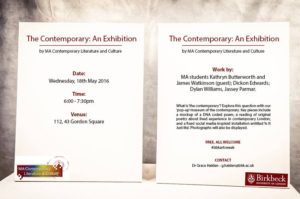
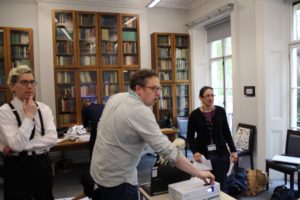
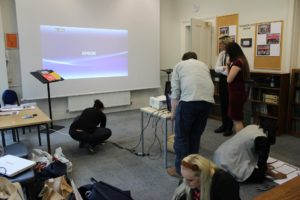
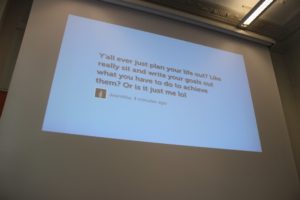
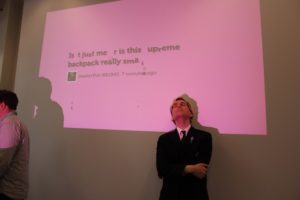
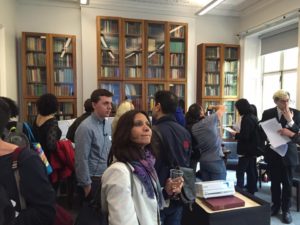
And here’s a link to the Facebook page for the MA in Contemporary Lit and Culture
***
Thursday 19th May 2016. Thinking more about Prince, and about camp uses of the colour purple, I’m reminded of this anecdote from Gary McMahon’s Camp in Literature (2006, p. 144):
‘Brigid Brophy notes that [Ronald] Firbank often wrote his tales in purple ink on blue postcards, surface and colour being everything to camp. Brophy reveals that she too wrote her critical biography of the man [Prancing Novelist, 1973] in purple ink. My working copy of Brophy’s book is on loan from Manchester University’s library. At this purple confession on page 173, a university student […] has written this response in the margin:
“Are you [Brophy] really as besotted as this? If so, we don’t want to know. At least maintain a pretence at objectivity, please.”
McMahon remarks that this student represents a certain academic sensibility ‘that is always going to be exasperated and offended by camp’.
Returning to Prince, I think of a friend’s anecdote along the same lines. When this friend was growing up in the 80s, some blokish gentleman known to them – a friend or possibly a dad – took one look at a Prince record sleeve and remarked, quite out of the blue, ‘I don’t care what he sounds like. I’m not listening to anyone who dresses like that.’
***
Friday 20th May 2016. I receive the grade for my second essay on the MA. Despite my struggles with it, I am very pleased indeed to get a 76 (a mark over 70 is a Distinction, the MA equivalent of a First). The first essay got a 73. It’s a nice boost to my confidence when I needed it most, wracked as I was with Difficult Second Term Syndrome.
For the rest of the summer, I have to get on with postgraduate-y things under my own steam, such as attending open lectures and pursuing my own research. But as far as the big assessments go, the pressure is off until the autumn.
Tags:
art,
birkbeck,
birkbeck arts week,
brigid brophy,
colony room,
little paper slipper,
Prince,
ronald firbank,
sophie parkin,
vout-o-reenee's
Friday 13th May 2016. Early afternoon: I’m recognised in Jermyn Street by a gentleman who says he enjoys this diary. In fact, he crosses the street to tell me this, narrowly avoiding being run down. Surely no writer can ask for higher praise than this: a reader risking their own life to pass on a good review. Perhaps it should go on the back of a book. ‘I enjoyed Dickon Edwards so much, I was nearly hospitalised’.
He adds that he was disappointed I didn’t say more about the death of Prince, given what I’d said about Bowie a few months earlier. This is a perfectly good point.
I think one reason might be that, when I was growing up, I’d always regarded Prince as one of my brother Tom’s favourites; his territory more than mine. For some reason we divided up singers and bands between us, as if they were soft toy animals. I got to cuddle New Order, the Pixies and the Smiths, Tom had the Cult, the Beastie Boys, and Prince.
But if one loves good pop songs, and believes, as I do, that pop music is at its best when used as a platform for individuality, eccentricity, and indeed dandyism, obviously one has to admire Prince.
It’s all the more apt that this request took place on Jermyn Street. The street is something of a dandy Mecca, being home to some of London’s most stylish menswear shops, to the church of St James’s Piccadilly, where Sebastian Horsley had his funeral in a red squinned coffin, and to a statue to that most influential of London dandies, Beau Brummel. It is a statue close enough to the ground to be hugged, an act which dandyish American friends of mine make a point of doing whenever they visit.
A further coincidence is that I was on my way to the London Library, a block away in St James’s Square. After parting company with the reader, I remember that I’d once found a book on dandyism in the library, one which directly compared Prince with Beau Brummell. So today I go straight into the stacks and retrieve the book in question.
The book is called Rising Star: Dandyism, Gender and Performance in the Fin de Siècle, by Rhonda K. Garelick (Princeton, NJ: Princeton University Press, 1998). As part of a chapter on the legacy of dandyism, Garelick reprints a 1995 Esquire cover, on which Prince pulls a definite dandyish pose. It’s from his Artist Formerly Known As phase, just after his hit, ‘The Most Beautiful Girl In The World’. His hair at this point is short, dark, combed and straightened, with a touch of the silkily feminine (even a Hugh Grant-ish schoolboy floppiness). He has a thin pencil beard that seems an extension of his cheekbones, and wears a slim pinstripe suit, buttoned down, over a white shirt with big cuffs. He sports a dark tie (collar button undone), fingers covered in rings, and leans against a silver cane.
According to Garelick, Prince’s image at this point follows in the classic nineteenth-century dandy traits. Prince ‘borrows unmistakably from the likes of Beau Brummell, Baudelaire and Jean Lorrain’. The main criteria are his aloofness, his air of contempt for convention, and his highly stylized persona. On top of that, his 1990s adoption of an unpronounceable symbol allies him with Barbey d’Aurevilly’s idea of the dandy life: one of pure surface and symbol, an influence beyond language: the dandy is ‘that which can hardly be recounted’. Certainly, changing one’s name to an actual symbol takes that aspect of dandyism to the limit. Though I’d say Prince had already put his stamp on language by that point, given his love of turning words into single letters or numbers, as in ‘I Would Die 4 U’.
The gendered aspects of Prince’s dandyism were equally fascinating. Granted, it may not have been original for a male, black, American performer to play with femininity in the rock and pop field; one thinks of Little Richard and Rick James. But Prince used his influences in order to do as Bowie did: make something new. He especially intensified the androgynous aspects of his imagery, imbuing them with that most deviant of colours – purple.
I think of that campest of pre-war dandy writers, Ronald Firbank, and his love of writing with purple ink. I also think of Brigid Brophy taking this detail of Firbank’s so much to heart, she apparently switched to using purple ink for the longhand manuscript of Prancing Novelist, her 1973 study of Firbank. The Brophy book is 600 pages long. That’s a lot of purple.
Through these deviant codes, Prince’s dandyism became an outrageous queering of heterosexuality – a machismo-troubling version of Camp Rock which he shared with such figures as Marc Bolan, Tiny Tim and Russell Brand (who isn’t even a musician, but he hasn’t let that stop him).
Garelick’s book also compares Prince’s use of female dancers and co-singers with names as Vanity, Apollonia, and Mayte, as echoing 1890s Decadent ‘tableaux’, such as ‘Aubrey Beardsley’s Salome drawings of androgynous, erotic, and nearly twin creatures’. Though in Prince’s case, says Garelick, the women were not so much twins as shadows in his wake, a ‘merging of the dandy and the danseuse‘.
Certainly, any woman appearing with Prince had to become remade in his image. I never saw Prince in concert, but I was interested enough to catch his 1987 concert film Sign o’ the Times, when it hit British cinemas. For the song ‘U Got The Look’, the female role was filled by the Scottish singer Sheena Easton, who’d already had a successful career in her own right. For ‘U Got The Look’, though, she became well and truly Prince-i-fied. From her singing to her clothes to her poses, she was not so much a guest vocalist as just another interchangeable cog in the man’s machine. When in Purple Rome, you do as the Purple Roman does.
More recently, I thought of Prince when I heard the song ‘Quicksand’ by La Roux, aka Elly Jackson, a young singer who might herself be described as a dandy (the National Portrait Gallery’s shop currently has her on a postcard, wearing a very Bowie-esque mustard yellow suit). Musically, ‘Quicksand’ is clearly influenced by ‘When Doves Cry’, from the chords to the clipped 80s synths. But Ms Jackson’s singing is a very Prince-like style too: shifting across the genders from high feminine falsetto to low, growing boyish swagger. For me, that’s when art is at its best: when there’s a breaking out of prescribed roles, and the same trappings of said roles are re-used on the artist’s own terms, to communicate their individualism. And that’s also a definition of dandyism, in my book.
***
Evening: to the ICA to see Mustang, a Turkish film, set in the present day, about five teenage orphan sisters living in what seems like an idyllic picturesque setting: a hillside village near the Black Sea coast. Their mildly rebellious behaviour during the school holidays, however, sees them dramatically punished by their guardians – first with imprisonment in their own home, complete with bars on the windows, and then into forced marriage to equally reluctant young men. The film’s sensualised, slightly surreal atmosphere accentuates the idea of a close-knit group of girls disappearing into a world of their own, thus placing the film in the same tradition as Picnic at Hanging Rock, The Virgin Suicides, and last year’s The Falling.
With the added dimension of the conservative Turkish setting, though, Mustang has more complex questions about the role of arranged marriage in a changing world. The girls’ captor, their grandmother, is no fairy tale tyrant; she merely believes that, because she herself was married off straight after puberty, that’s the way it should be. Indeed, for one of the sisters, her marriage to the boy she was already seeing is shown as a good thing, if a hasty one. For the others, though, freedom comes in the form of escape to the big city – Istanbul – and to the parent they really want: a beloved schoolteacher. The real asset of the film, though, is the utterly naturalistic and convincing performances, particularly by the youngest sister.
Tags:
brigid brophy,
Dandyism,
ICA,
jermyn street,
la roux,
Mustang,
Prince,
ronald firbank,
The London Library











